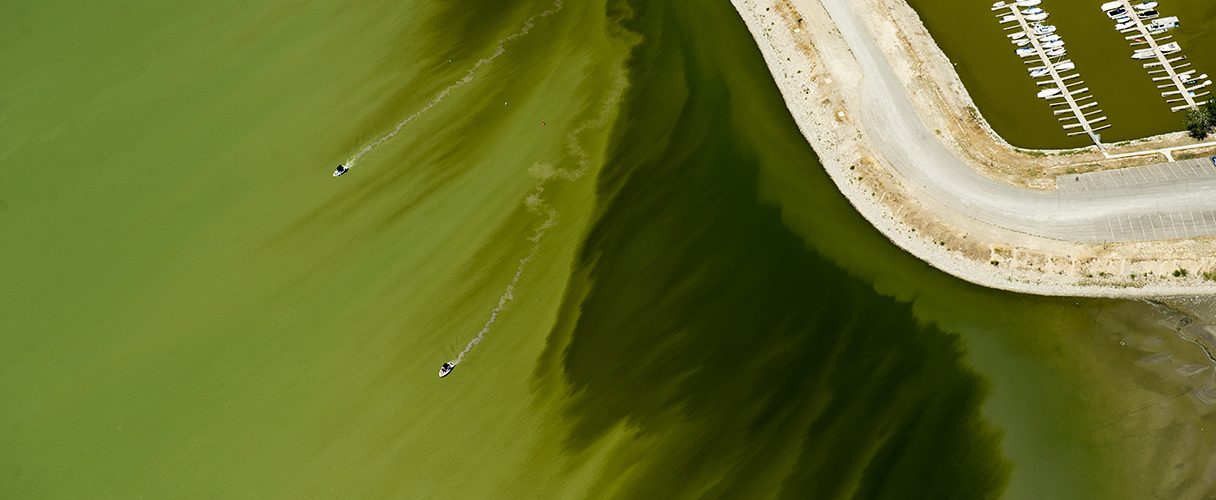To tame lake-fouling algal blooms, try an ecosystem approach
Every summer, surges of toxic green muck plague lakes worldwide, sickening hikers who fail to purify drinking water, closing favorite swimming holes, and killing fish. The most feared—and studied—cause of these freshwater “algal” blooms is a genus of cyanobacterium called Microcystis. Its explosive summer growth is thought to be spurred by rising levels of phosphorus, nitrogen, and other nutrients, perhaps from fertilizer run off or other pollution sources. But new research, driven by advances in DNA sequencing, suggests other types of microbes also play key roles in these massive overgrowths.
每年夏天,有毒的绿色淤泥涌入世界各地的湖泊,使不能净化饮用水的徒步旅行者感到恶心,关闭最喜欢的游泳池,杀死池塘中的鱼类。造成这些淡水“藻类”大量繁殖的最令人恐惧的ーー也是研究最多的ーー是一种名为微囊藻(microcystis)的蓝细菌属。夏季的爆炸性增长被认为是由于磷、氮和其他营养物质水平的上升,也许是肥料流失或其他污染源造成的。但是,在 DNA 测序技术进步的推动下,新的研究表明,其他类型的微生物也在这些大规模过度生长中发挥着关键作用。
According to one study, viruses killing off a main competitor of toxic Microcystis may help pave the way for blooms; another indicates nitrogen fixation by other bacteria may provide the needed boost. The results suggest that reducing nutrients may not be enough to stop these slimy explosions, some scientists say. That doesn’t mean curbing pollution is unimportant, they stress, but ecological factors must be considered.
根据一项研究,杀死有毒微囊藻的主要竞争对手的病毒可能有助于为水华铺平道路,另一项研究表明,其他细菌的固氮作用可能提供所需的促进作用。一些科学家说,研究结果表明,减少营养可能不足以阻止这些水藻的爆发式增长。他们强调,这并不意味着控制污染不重要,但必须将生态因素纳入考虑范围内。
“Interspecies biological interactions help determine blooms,” says Kevin Johnson, a marine scientist at the Florida Institute of Technology who was not involved in the work. “The more details we understand of bloom creation, the better our knowledge of how they might be prevented or controlled.”
“物种间的生物相互作用有助于确定水华成因,”凯文·约翰逊,一位在佛罗里达州理工学院且没有参与这项工作的海洋科学家如是说。“我们对藻类的爆发式生长现象了解得越多,我们对如何防止或控制它们的了解就越多。”
With the warming climate and continuing inflows of pollution, harmful algal blooms are on the rise, becoming more frequent and longer lasting in ever more places across the globe. They are “a pretty wicked problem,” says Ariane Peralta, a microbial ecologist at Eastern Carolina University
随着气候变暖和污染物不断涌入,有害藻类大量繁殖的现象在全球越来越多的地方将会变得越来越频繁,持续时间也会越来越长。东卡罗莱纳大学的微生物生态学家阿丽亚娜·佩拉尔塔说,它们是“一个相当有害的问题”。
In some lakes, reducing fertilizer runoff at first seemed to thwart blooms—then they came back. Similar plans for bloom-choked Lake Erie might backfire, a team of academic microbiologists and water quality experts funded by the National Science Foundation and other U.S. agencies reported in May. A 2014 bloom there caused such severe shortages of drinking water in the nearby city of Toledo, Ohio, that Canada and the United States have agreed to cut phosphorus going into the lake by 40%.
在一些湖泊中,减少肥料流失起初似乎可以阻止水华,但后来水华又回来了。由国家科学基金会和其他美国机构资助的一个由学术微生物学家和水质专家组成的团队在五月份的报告中说,类似的计划可能会适得其反。2014年的水华造成了附近俄亥俄州托莱多市严重的饮用水短缺,加拿大和美国已经同意将流入湖中的磷减少40% 。
But a simulation of that strategy, along with an analysis of more than 100 related scientific papers, led the team to conclude that although limiting phosphorus might shrink Lake Erie blooms, they could also grow more toxic: with lower overall growth of microbes, any photosynthetic Microcystis left would receive more sunlight and have more nitrogen available, two conditions that favor an increase in their production of microcystin, a substance that make the blooms toxic. They suggested the lake’s nitrogen should also be curtailed.
但是,通过对这一策略的模拟,以及对100多篇相关科学论文的分析,研究小组得出结论: 尽管限制磷的使用可能会使伊利湖水华缩小,但是它们也可能增加更多的毒性: 随着微生物总体生长速度的降低,任何光合作用的微囊藻都会接收更多的阳光,并获得更多的氮,这两个条件都有利于微囊藻毒素的产生,这种物质会使水华变得有毒。他们建议湖中的氮也应该减少。
Read more at Science.org
更多信息请移步Science.org











